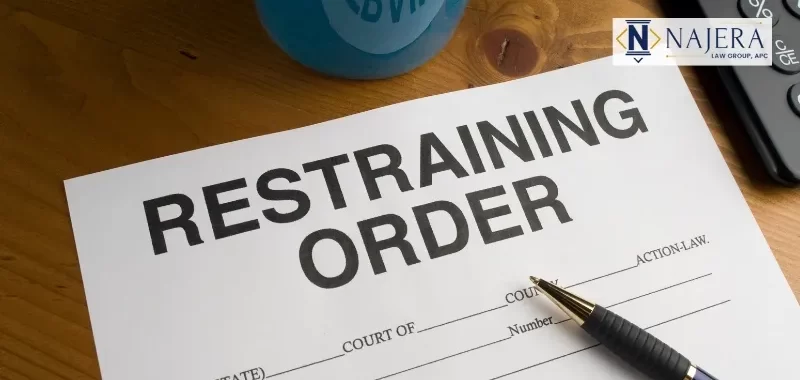|
|
Last Modified on Aug 14, 2025
Restraining orders are a useful tool for providing safety to many Californians. However, you may be confused about the details and length of the order. A common concern clients share is “How long does a restraining order last in California?”. Our team at Najera Law Group, APC, is here to answer that question.
Our Background
Najera Law Group, APC, has spent years aiding people across Riverside County with their family law and criminal defense matters. Our founder, E. Steve Najera, has decades of experience working in California law, litigating over one hundred trials. While working as a deputy trial attorney in Orange County, he received Don Simm’s Trial Attorney of the Year award.
Restraining Order Overview
The most common reason for a restraining order of all types is domestic violence. Domestic violence remains an important safety issue, with law enforcement in California receiving more than 160,000 calls related to domestic violence. Nationwide, 1 in 3 women and 1 in 7 men over the age of 18 experience domestic violence. If you fear for your immediate safety, call 9-1-1 or utilize Riverside County’s list of local resources and centers.
Other common reasons for filing a restraining order include civil, workplace, or criminal harassment.
Types of Restraining Orders
How long your restraining order lasts depends on the type of order you file for. Some last days, while others last years. The following are the general categories for protective orders filed in California.
Emergency Protective Order
The first type of protective order is an Emergency Protective Order (EPO). These protective orders are issued by police officers when they believe you are in immediate danger and are approved by a judicial officer. EPO’s last five days of official judicial business, or seven days after it was issued, whichever comes first.
Temporary Protective Order
The second classification of restraining order is a Temporary Protective Order (TPO). Unlike EPOs, anyone experiencing harassment can file a TPO. TPOs require a same-day ruling, where a hearing to review the case will be set for a day within 21 days, or 25 days if there is good cause for delay. The hearing occurs whether your TPO is approved or declined, and if granted, your TPO lasts until then.
Long-Term Protective Order
The third category is long-term, or final, restraining orders. You are not required to receive a TPO before filing for a long-term restraining order, but the hearing set during a TPO process is the most common way in which final orders are given. The person filed against is likely to appear at this hearing, as they will be given ample notice.
Long-term protective order timelines change depending on the reason for the hearing. For domestic violence restraining orders, the maximum length is five years. These cases may be renewed for an additional five years, an indefinite number of times, as long as they’re filed within three months of the expiration date. Civil harassment restraining orders have the same regulations, with the only difference being a default expiration date of three years if not specified.
Workplace violence restraining orders are a similar yet separate type of protective order to domestic violence and civil harassment cases. The first major difference is that an employer files them, rather than the protected person. Another notable change is that workplace violence restraining orders have a three-year time limit. As with other long-term cases, cases can be renewed within three months of expiration.
Hire a Restraining Order Lawyer
Facing the person you are filing against in court can be both emotionally and legally challenging. It is recommended that you hire a restraining order lawyer who can advocate for your needs. Your restraining order attorney can handle the paperwork and collect the evidence required for a long-term restraining order.
Facing a restraining order on the accused side can also be difficult. Proving your innocence can be tough on your own. Your restraining order attorney can advocate with evidence of the quality of your character.
FAQs
Is It Hard to Get a Long-Term Restraining Order in California?
How hard it is to get a permanent restraining order in California depends on the strength of your evidence and argument. You must provide ample proof that you have a fear of harm from the accused and have been a victim of harassment or abuse under state law standards. Texts, recordings, photos, and other physical evidence can make it easier to get a long-term restraining order.
How Long Does a Restraining Order Stay on Your Record in California?
If a restraining order has been filed against you, you may be worried about how long it will remain on your record. The ability to remove a restraining order from your record depends on the type and circumstances. A granted, long-term protective order will remain on your record and can be very difficult to get removed. A denied or dismissed case can be potentially sealed through an expungement process. Your restraining order attorney can provide you with options.
What Are the Rules of a Restraining Order in California?
The rules for a restraining order in California are that the restrained person must maintain no contact with the protected person. This includes maintaining physical distance and refraining from any form of communication via text, phone, or email. The restrained person is also forbidden from possessing firearms. Violating these terms may result in arrest, jail time up to a year, and a fine worth $2000 or less.
Do You Need a Restraining Order Lawyer in California?
California does not require you to have a restraining order lawyer to receive any protective order. Emergency protective orders have no input from the protected person, and TPOs have fast resolutions. However, having legal guidance during the hearing for a long-term restraining order can greatly affect the outcome of your case. Your restraining order lawyer can have knowledge of similar cases that can aid in providing the necessary evidence to get long-term protection.
Speak With a Restraining Order Attorney Today
At Najera Law Group, APC, we understand how stressful situations requiring restraining orders can be. Contact us today for an initial consultation where we can begin discussing your restraining order case. You may also visit our Riverside Office, located in the heart of Riverside, a block away from City Hall.




